Final report for FNC17-1088
Project Information
We are growing microgreens and edible flowers on a small farm. We grow the microgreens indoors in an area of less than 300 square feet. We have been doing this for three years. We were not using any sustainable practices prior to starting this grant.
The problem remains one of finding economic viability for the small scale microgreen grower. Our research so far is leading us to the path of composting and reuse of the soilless mixes. Completely changed from where I started. Thought for certain I would find another medium but instead ended up with composting the soilless mix.The comparison across the initial 27 weeks supports this idea. I am currently composting the used soilless mix and will compare it to previous results.
Our project objectives remain unchanged.
- Identify a microgreen growing medium more economical and environmentally friendly than a purchased soilless mix.
- Protect peat moss environments in Canada and associated flora and fauna by identifying an alternative microgreen growing medium.
- Lower commercial crop production cost of microgreens.
- Empower kids and their families to grow low cost, nutritious, economically sound and ecologically friendly food.
Research
Our process revolved around selecting grow mediums (our variables) and comparing the results while ensuring our constants (temperature, humidity, seed density by crop, and light exposure) remained so across the board in order to compare yield/cost to alternatives to using commercially available soilless mixes that contain peat. We selected one soilless peat mix and have selected a biostrate, cellulose and hemp mats to compare against it. For our seed choice, we selected one company to provide all seeds and kept to that single variety. The four types of seed we choose were broccoli, radish, mizuna mustard and cabbage. We also decided that each week we would plant four trays of each variety. We planted in standard 10" x 20" trays. We decided to to plant all trays at 14 grams of seed per tray. Our lights were set to 12 hours per day and we watered each tray by hand with 1.5 cups once a day. Seeds were planted by hand, pressed onto the growing medium, watered and monitored for germination. We also placed paper towels on top of the seeds/growing medium and stacked the trays four deep. Each day prior to placing under the lights we watered very lightly and rotated from top to bottom tray placement in the stacks. Usually around Day 3 we found enough growth to move the trays under the grow lights. Day 10 found plants harvest ready.
Based upon our initial results we are moving towards composting our soilless mix for reuse.
| Growing Microgreens using various mediums | Harvest in ounces | ||||
| Week | BROCCOLI | RADISH | MIZUNA | CABBAGE | |
| SOILLESS MIX | 1 | 28 | 4.3 | 3.5 | 3 |
| 2 | 3 | 6.3 | 3.6 | 6 | |
| 3 | 3.3 | 6 | 3.5 | 2.8 | |
| 4 | 4 | 5.5 | 2.6 | 2.9 | |
| 5 | 5.3 | 5.5 | 3.5 | 5.4 | |
| 6 | 5.4 | 6 | 4.5 | 5.2 | |
| 7 | 6.2 | 6.2 | 5 | 5.6 | |
| 8 | 3.4 | 4.8 | 4.2 | 4.6 | |
| 9 | 3.2 | 3.9 | 3.1 | 5.6 | |
| 10 | 3.6 | 4.6 | 4.4 | 4.8 | |
| 11 | 3.5 | 4.4 | 4.1 | 5.2 | |
| 12 | 6.3 | 4.3 | 4.8 | 4.8 | |
| 13 | 3.7 | 4.7 | 3.9 | 4.4 | |
| 14 | 7.3 | 6.1 | 3.3 | 5.2 | |
| 15 | 6.8 | 4.7 | 5.8 | 5 | |
| 16 | 2.4 | 4.6 | 3.2 | 4.8 | |
| 17 | 4.6 | 4.6 | 4 | 4.8 | |
| 18 | 5.2 | 4.6 | 4.5 | 4.8 | |
| 19 | 5 | 4.6 | 4.2 | 5 | |
| 20 | 4.3 | 5.9 | 6.1 | 5.2 | |
| 21 | 4.1 | 5.5 | 3.6 | 5 | |
| 22 | 4.3 | 4.9 | 4.4 | 4.8 | |
| 23 | 4.5 | 4.9 | 4.2 | 5.2 | |
| 24 | 3.8 | 5 | 3.9 | 5 | |
| 25 | 4.7 | 5.5 | 3.8 | 5.2 | |
| 26 | 4.9 | 5.2 | 4.7 | 4.8 | |
| 27 | 4.3 | 6.3 | 4.5 | 5 | |
| AVERAGE | 5.4 | 5.1 | 4.1 | 4.8 | |
| BIOSTRATE (FIBER/FELT) | 1 | 1.6 | 2.3 | 0.4 | 1.2 |
| 2 | 2 | 1.6 | 0.4 | 0 | |
| 3 | 2 | 0.2 | 0.4 | 0.5 | |
| 4 | 2.1 | 2 | 1.2 | 1.1 | |
| 5 | 2 | 1.2 | 0.4 | 1.2 | |
| 6 | 1.7 | 2 | 0.4 | 1.4 | |
| 7 | 1.6 | 2.1 | 0.4 | 1.1 | |
| 8 | 1 | 2 | 0.6 | 0.3 | |
| 9 | 0.3 | 1 | 0.2 | 0.7 | |
| 10 | 0.9 | 2 | 0.8 | 0.3 | |
| 11 | 1.7 | 1.5 | 0.8 | 1.6 | |
| 12 | 1.6 | 1.6 | 0.2 | 1.5 | |
| 13 | 1.5 | 1.3 | 0 | 0.7 | |
| 14 | 0.9 | 1.2 | 0.2 | 1.1 | |
| 15 | 1.4 | 1.6 | 0 | 1.3 | |
| 16 | 1.7 | 1.1 | 0.3 | 1.2 | |
| 17 | 1.7 | 1.6 | 1 | 1 | |
| 18 | 2 | 2.5 | 0.1 | 1.5 | |
| 19 | 2.1 | 2.4 | 1.2 | 1.6 | |
| 20 | 1.6 | 2.2 | 1.2 | 1.2 | |
| 21 | 1.9 | 2.3 | 1 | 1.3 | |
| 22 | 2.2 | 2.2 | 0.8 | 1.2 | |
| 23 | 2.1 | 2 | 1 | 1.1 | |
| 24 | 2 | 1.8 | 1.1 | 1.5 | |
| 25 | 2 | 2 | 1 | 1 | |
| 26 | 1.8 | 2.2 | 1.2 | 1.6 | |
| 27 | 2 | 2.1 | 1 | 1.3 | |
| AVERAGE | 1.7 | 1.8 | 0.64 | 1.1 | |
| CELLULOSE | 1 | 1.5 | 1.6 | 1 | 1.3 |
| 2 | 1.6 | 2.1 | 1.5 | 0 | |
| 3 | 0 | 1 | 0.3 | 1.2 | |
| 4 | 1.5 | 1.8 | 0.8 | 1.8 | |
| 5 | 1.6 | 1.3 | 1.4 | 1.6 | |
| 6 | 1 | 1.4 | 0.4 | 0.2 | |
| 7 | 1.2 | 1.7 | 0 | 1.3 | |
| 8 | 1.2 | 1.4 | 0.7 | 0 | |
| 9 | 1.3 | 1.1 | 0.8 | 1.3 | |
| 10 | 1.2 | 0.2 | 0.8 | 0.3 | |
| 11 | 1.3 | 0.7 | 0.3 | 1.2 | |
| 12 | 1.7 | 0.7 | 0.8 | 0.2 | |
| 13 | 0.8 | 0.4 | 0.2 | 0.8 | |
| 14 | 0.8 | 0.9 | 0.3 | 1.2 | |
| 15 | 1.7 | 1.9 | 0.7 | 0.6 | |
| 16 | 0 | 1.1 | 1.2 | 0 | |
| 17 | 0.6 | 1.7 | 0.3 | 0.2 | |
| 18 | 2 | 2.2 | 1.3 | 1.2 | |
| 19 | 2.2 | 1.4 | 1.3 | 1.1 | |
| 20 | 2.3 | 1.3 | 1.4 | 0.8 | |
| 21 | 2.2 | 1.5 | 1.2 | 0.9 | |
| 22 | 2.2 | 1.4 | 1.4 | 0.7 | |
| 23 | 1.8 | 1.8 | 1.3 | 0.8 | |
| 24 | 2 | 1.3 | 1 | 1 | |
| 25 | 2 | 0.9 | 1.4 | 1.1 | |
| 26 | 2.3 | 1.4 | 1.2 | 1.1 | |
| 27 | 2.3 | 1.9 | 1.5 | 0.9 | |
| AVERAGE | 1.5 | 1.3 | 0.91 | 0.84 | |
| HEMP MATS | 1 | 1.7 | 2.5 | 1.9 | 0.6 |
| 2 | 0.5 | 3.3 | 2.3 | 2.4 | |
| 3 | 3.3 | 0 | 0.3 | 2.2 | |
| 4 | 4 | 3.3 | 2.5 | 2.1 | |
| 5 | 3.5 | 3.7 | 3.4 | 2.8 | |
| 6 | 3.1 | 4.6 | 2.6 | 2.6 | |
| 7 | 4.3 | 2.9 | 2.6 | 2.3 | |
| 8 | 2.7 | 1.9 | 0.5 | 0.6 | |
| 9 | 3 | 2 | 3.4 | 2.5 | |
| 10 | 1.4 | 2 | 1.2 | 0.3 | |
| 11 | 1.3 | 0.7 | 2.3 | 2.4 | |
| 12 | 1.1 | 0.2 | 0.2 | 2.3 | |
| 13 | 1.8 | 1 | 1 | 0 | |
| 14 | 1.7 | 1.2 | 1 | 1 | |
| 15 | 2.2 | 1.2 | 1 | 0.1 | |
| 16 | 3 | 0.8 | 1.2 | 0.9 | |
| 17 | 3.5 | 2.8 | 1.8 | 1.6 | |
| 18 | 1.5 | 3.6 | 1.5 | 1 | |
| 19 | 3.6 | 3.8 | 1 | 2 | |
| 20 | 3.2 | 3.4 | 1.6 | 1.8 | |
| 21 | 2.3 | 2.7 | 1.5 | 2 | |
| 22 | 2.8 | 2.8 | 2.1 | 2.5 | |
| 23 | 2.2 | 3.2 | 1 | 2 | |
| 24 | 1 | 2.9 | 2.3 | 1.8 | |
| 25 | 8 | 3.4 | 2 | 2.3 | |
| 26 | 3 | 3.7 | 2.5 | 2.4 | |
| 27 | 2.6 | 3.8 | 2.8 | 2.3 | |
| AVERAGE | 2.7 | 2.5 | 1.8 | 1.7 |
Educational & Outreach Activities
Participation Summary:
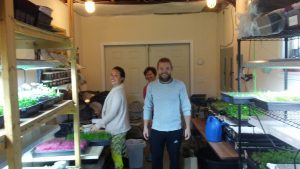
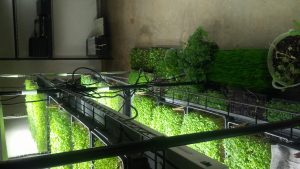
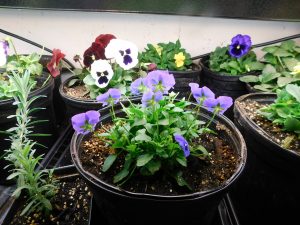
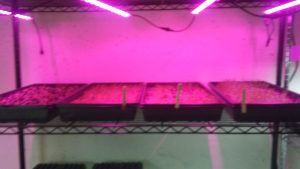
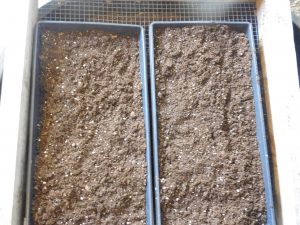
My project gradually morphed from exploration of microgreen medium selection to choice. My message also morphed and broadened into sharing my results on seeding density, seed choice, light requirements (both lumens and equipment cost/durability), edible flowers, composting using standard pile versus three bin composter, and even marketing. I have been sharing my results with two microgreen growing groups on Facebook as well as with face-to-face conversations with other farmers.
Community outreach included working with a science teacher at Terre Haute South High School. About 50 microgreen starter kits were distributed to students who took them home to grow their own microgreens.
Learning Outcomes
We are still learning and discovered that for us there is a huge learning curve in adjusting to growing microgreens in alternatives to the traditional soilless mediums. We are leaning towards composting our soilless mix and reusing it as an alternative to purchasing mediums once the grant is completed. We have built a three bin composter to initiate this and discover how reworking the soilless mix works for our purposes. We also built a standard turn pile.
I would recommend growers select a soilless mix as their medium of choice and aggressively compost in order to reduce cost, reduce waste and improve profit. This has resulted in a decline in our cost of over $1.50 per tray. The majority of our cost was for the soilless mix. The cost of other mediums was comparable. The results in productivity for the alternative mediums were less and we could not compost those mediums for reuse. Again use soilless mix, compost with whatever method works for you and reap the benefits.
I encourage other to turn towards soilless mix composting.
Project Outcomes
I think the future lies in soilless mix composting and reuse for microgreens. The longer I worked with other mediums and practiced composting the more certain I became. I think it would be great if outreach on composting could be encouraged as a method to preserve what we have.
I have built a three-bin composter (each bin contains roughly one cubic meter) to experiment with the length of time it takes to break down down roots and other vegetative matter. My average was eight weeks from tray dump to dirt sifting for new trays during the summer. That means I need at a minimum three three-bin composters -- each able to hold a weeks work of soil. This effectively saved me nine weeks of soilless mix cost. However with the return of cold weather that will change as my demand will outstrip my current output. I will continue to monitor the efficacy over the winter.
My composter sits outside and is negatively effected by weather in the colder months. I think a three walled and ceiling structure that fully breaks the prevailing winds is needed to compost year round in my environment. Without a way to effectively compost, the end result in Spring will be a huge mass of materials that will require me to construct at least one or perhaps even two more composters. Collecting and preserving green materials (lawn clipping, dried leaves etc.) is a necessity and requires its own separate storage even if only under a tarp.